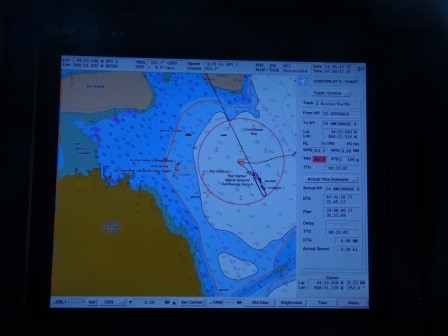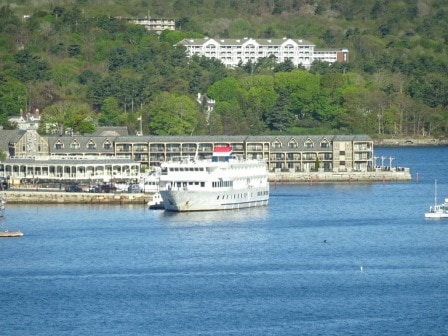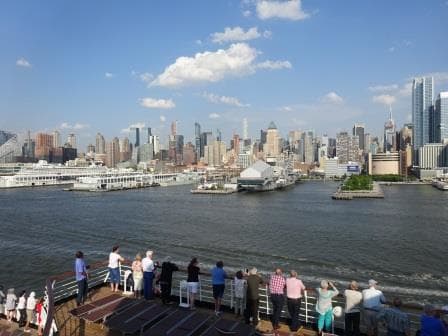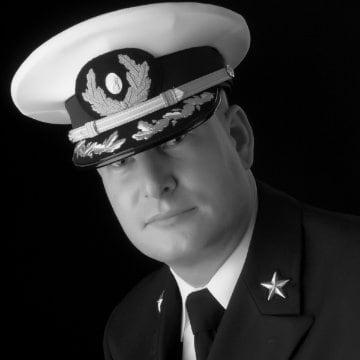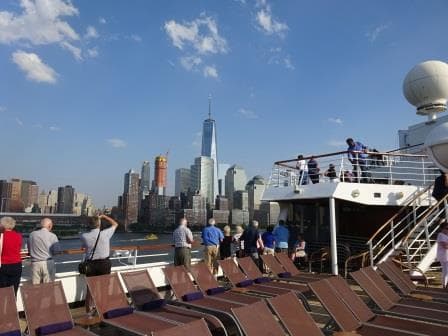Bar Harbor has two anchorages for cruise ships. In principle there is more space for more ships but those anchorages are hampered by two problems. A. the tender distance to town is becoming to long to provide a good service B. those areas are currently full of lobster pots so you cannot anchor there without upsetting a lot of people,……. those who own those lobster pots.
But the two anchorages which are officially allocated are normally kept free of lobster pots (sort of…..) the most coveted anchorage is the south anchorage as here you can tender in a straight line from the ship to the dock. Handy for the officer on the bridge to keep an eye on the tenders and handy for the tender drivers when the visibility gets less as they only have to continue sailing in a straight line. (That line they can see on a plotter which we have in the tenders and mark with GPS constantly the position of the tender. So if you have your first line on the screen, then you can just keep your tender on that line for the next run.
The North Anchorage is on the other side of a small island. That island blocks the view of the port and prevents tenders from sailing in a straight line. The officer on the bridge cannot see where the tenders are and the tenders have to sail around the island (and also around a plethora of lobster pots) to get to the shore and to get back to the ship. Thus they only way we can follow the tenders is with the AIS transponders they all have, so we can see them moving over the radar screen. But an AIS transponder always has a certain delay or lag time and that is something we do not like.
But we dropped the hook on the south anchorage and stayed there from 0700 to 1500 hrs. during what became a glorious day. Sunny, not too warm and just a gentle breeze. Outside we had windforce five but the anchorage was really sheltered today. We had another cruise ship in port, the Independence but she is so small that she could dock right in down town. There are a few of these little cruiseships around and they are small enough to travel up and down the canal and fairways of the USA visiting small ports along the route. But they are also seaworthy enough to stick their bow out into open waters if it is nice weather.
I was on the foc’sle on arrival and departure and had my school classes in between. I like to be at standby’s, as the captain and the staff captain can never get there themselves as they are required on the bridge. Plus it is normally the junior officers who are forward and that gives me the chance to hand over a few tricks of the trade. Today the topic was mud. We can get highly excited about that, as mud affects the safe anchoring. There is solid mud, soft mud, mixed mud (with shells) and the anchor reacts to it in a different way. Bar Harbor has very thick grey mud with sometimes shells mixed into it. This means that the anchor flukes do not always dig in very well and then with a bit of wind the ship can cause the anchor to drag and the anchor chain to slide and slither over the sea bottom. If the mud is soft then it clings to the chain and when we go anchor up, we only see a grey thick pipe coming above water with the anchor chain somewhere inside it.
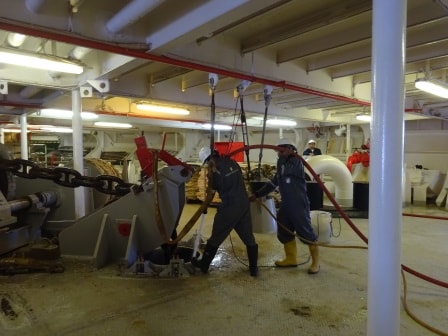
The battle against the mud. There are four 9 bar nozzles in the hawsepipe, a five bar jet of the fire hose and still we lose the battle sometimes.
We do not like all that mud to go into the chain locker and thus we have strong sprays of water in the hawse pipe (where the chain enters the ship) to clean it off. Four 90o degree angled & powerful 9 bar jets on the chain. But for Bar Harbor that is not enough, we need another two fire hoses to clean the rest off. That is a whole organization with winch handlers, sailors with fire hoses, proper regulation of the winch speed and taking advantage of the movement of the ship to use the water flow around the chain and anchor to help even more.
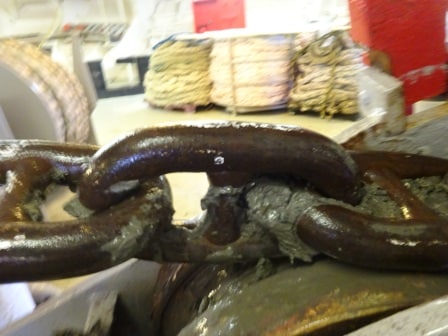
Thick grey mud strong enough to cling to the anchor chain after having been tormented by heavy water jets.
To coordinate this is a sort of balancing act and anticipating what will happen next by keeping in mind how the ship will maneuver. So this afternoon we had the regular 3rd officer forward plus two cadets all eager to learn how to deal with………… mud.
Tonight we will sail towards Halifax and about 8 pm. we will pass Cape Sable the South East point of Nova Scotia on which island Halifax is located. We are supposed to be docked by 09.00 hrs tomorrow morning and then have a full day in port.
Weather: more of the same. Behind us the rain is coming but at the moment we seem to be able to out run it for the whole of tomorrow.
